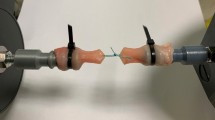Abstract
Objectives
The purpose of this study was to investigate the effects of esophagotomy closure techniques on the esophageal bursting pressure.
Materials and methods
Altogether, 122 freshly dead sheep esophagi received from the local slaughterhouse were prepared for manual closure. After esophagotomy, the specimens were divided into four groups. An interrupted mucosal suture pattern (n = 30), an interrupted mucosal-submucosal suture pattern (n = 30), an interrupted mucosal-submucosal + over-over continuous muscular suture pattern (n = 32), and an interrupted mucosal-submucosal + reinforcement with a diaphragmatic part with full-thickness interrupted U suture pattern (n = 30) were used for esophagotomy closure; 4-0 silk was used in all specimens. Bursting pressures were measured with a sphygmomanometer.
Results
We found a statistically significant difference among the bursting pressures of all groups (p < 0.001). The bursting pressure values gradually increased from group 1 to group 4 (47.6 ± 22.7, 86.2 ± 49.5, 185.4 ± 53.5, and 226.8 ± 62.4 mmHg, respectively). Reinforcing the esophageal suture line with tissue significantly increased the bursting pressure compared to the other groups.
Conclusions
Each layer of the esophagus significantly contributes to strengthening esophageal wall tension with primary esophageal closure, and reinforcement of the esophageal suture with tissue provides an additional significant increase in the bursting pressure of the esophagus.



Similar content being viewed by others
References
Bardaxoglou E, Manganas D, Meunier B, et al. (1997) New approach to surgical management of early esophageal thoracic perforation: primary suture repair reinforced with absorbable mesh and fibrin glue. World J Surg 21:618–621
Shields TW (2005) Esophageal trauma. In: Shields TW, Locicero J III, Ponn RB, et al., editors. General Thoracic Surgery. 6th edition.Vol. 2. Philadelphia, Lippincott Williams &Wilkins, pp 2101–2122
Oakes MG, Hosgood G, Snider TG, et al. (1993) Esophagotomy closure in the dog: a comparison of a double-layer appositional and two single-layer appositional techniques. Vet Surg 22:451–456
Shamir MH, Shahar R, Johnston DE (1999) Approaches to esophageal suturing. Compend Contin Educ Pract Vet 21:414–420
Ranen E, Shamir MH, Shahar R, et al. (2004) Partial esophagectomy with single layer closure for treatment of esophageal sarcomas in 6 dogs. Vet Surg 33:428–434
Peacock EE (1984) Wound Repair. 3rd edition. Philadelphia, Saunders, pp 433–439
Ogurtan Z, Gezici M, Kul M, et al. (2001) Compararative study of bursting and tensile strengths of digestive tract in the dog: application to esophago-intestinal sutures. Rev Med Vet 152:491–494
Tera H, Aberg C (1976) Tissue holding power to a single suture in different parts of the alimentary tract. Acta Chir Scand 142:343–348
Egorov VI, Schastlivtsev V, Turusov RA, et al. (2002) Participation of the intestinal layers in supplying of the mechanical strength of the intact and sutured gut. Eur Surg Res 34:425–431
Dallman MJ (1988) Functional suture-holding layer of the esophagus in the dog. J Am Vet Med Assoc 192:638–640
Gregersen H, Lee TC, Chien S, et al. (1999) Strain distribution in the layered wall of the esophagus. J Biomech Eng 121:442–448
Thornton FJ, Barbul A (1997) Healing in the gastrointestinal tract. Surg Clin North Am 77:549–573
Hendriks T, Mastboom WJ (1990) Healing of experimental intestinal anastomoses: parameters of repair. Dis Colon Rectum 33:891–901
Jönsson K, Jiborn H, Zederfeldt B (1987) Collagen metabolism in small intestinal anastomosis. Am J Surg 154:288–291
Hayari L, Hershko DD, Shoshani H, et al. (2004) Omentopexy improves vascularization and decreases stricture formation of esophageal anastomoses in a dog model. J Pediatr Surg 39:540–544
Jiborn H, Ahonen J, Zederfeldt B (1978) Healing of experimental colonic anastomoses. I. Bursting strength of the colon after left colon resection and anastomosis. Am J Surg 136:587–594
Rebuffat C, Rosati R, Fumagalli U, et al. (1996) Experimental oesophagogastric anastomosis: preliminary report of a new compression device that also fragments. Br J Surg 83:1616–1619
Radu A, Grosjean P, Jaquet Y, et al. (2005) Photodynamic therapy and endoscopic mucosal resection as minimally invasive approaches for the treatment of early esophageal tumors: pre-clinical and clinical experience in Lausanne. Photodiagn Photodynam Ther 2:35–44
Author information
Authors and Affiliations
Corresponding author
Rights and permissions
About this article
Cite this article
Yeginsu, A., Ergin, M. & Erkorkmaz, U. Strength of Esophageal Closure Techniques With and Without Tissue Reinforcement. World J Surg 31, 1445–1448 (2007). https://doi.org/10.1007/s00268-007-9084-5
Received:
Revised:
Accepted:
Published:
Issue Date:
DOI: https://doi.org/10.1007/s00268-007-9084-5




